Southern Cross University - Introduction to Business Law Assignment
VerifiedAdded on 2022/09/26
|9
|2069
|23
Homework Assignment
AI Summary
This document presents a comprehensive solution to an Introduction to Business Law assignment. The assignment addresses key concepts such as the intention to be legally bound in a contract, consideration, misrepresentation, and breach of contract. The solution analyzes scenarios involving friends making agreements, advertisements, and professional services. It explores the elements of contract formation, the importance of consideration, and the consequences of misrepresentation. The assignment also examines negligence and liability in contractual agreements, including the role of agents and the impact of non-performance of duties. The solution provides detailed explanations, relevant case laws, and legal reasoning to support the conclusions, covering various aspects of contract law and business law principles.
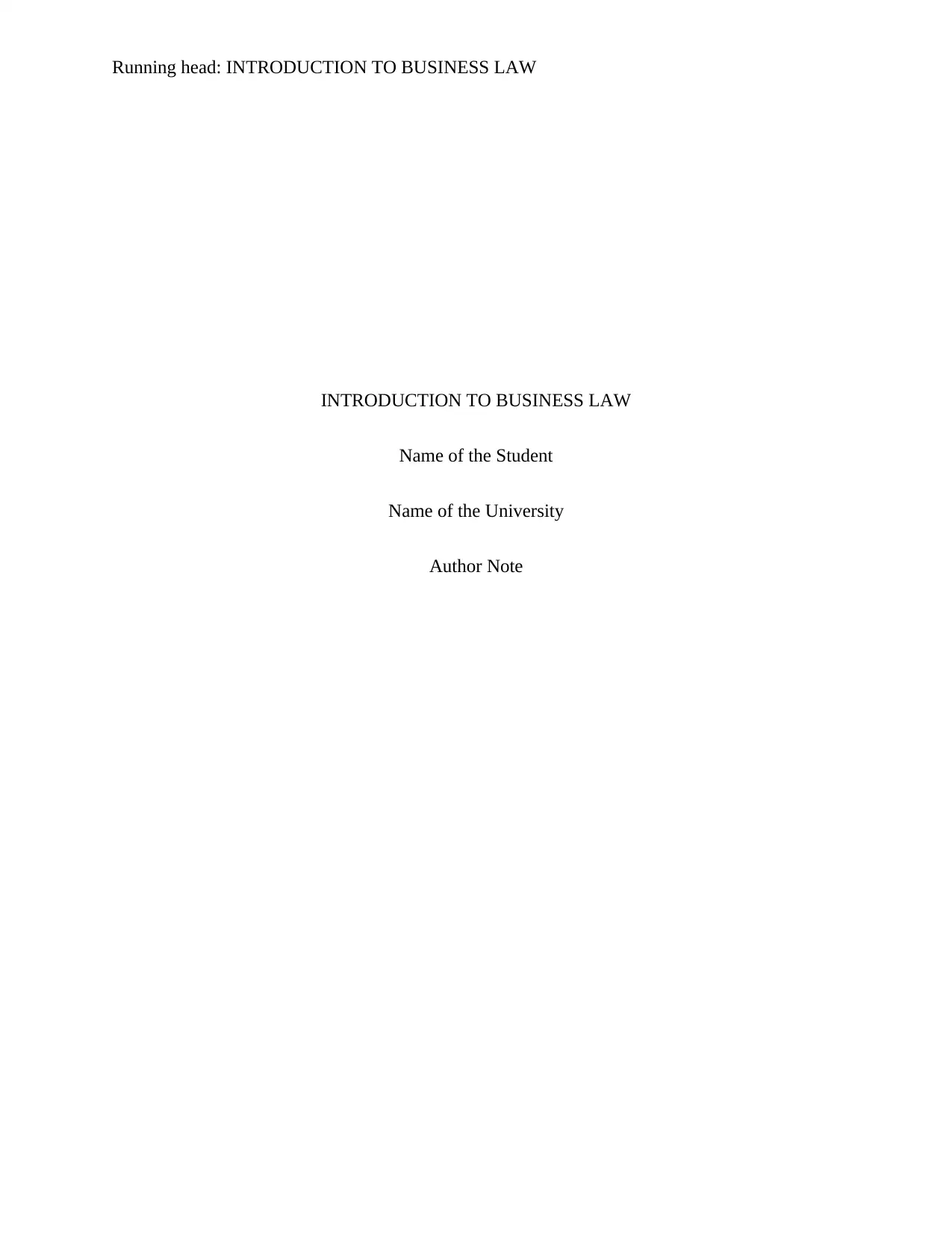
Running head: INTRODUCTION TO BUSINESS LAW
INTRODUCTION TO BUSINESS LAW
Name of the Student
Name of the University
Author Note
INTRODUCTION TO BUSINESS LAW
Name of the Student
Name of the University
Author Note
Paraphrase This Document
Need a fresh take? Get an instant paraphrase of this document with our AI Paraphraser
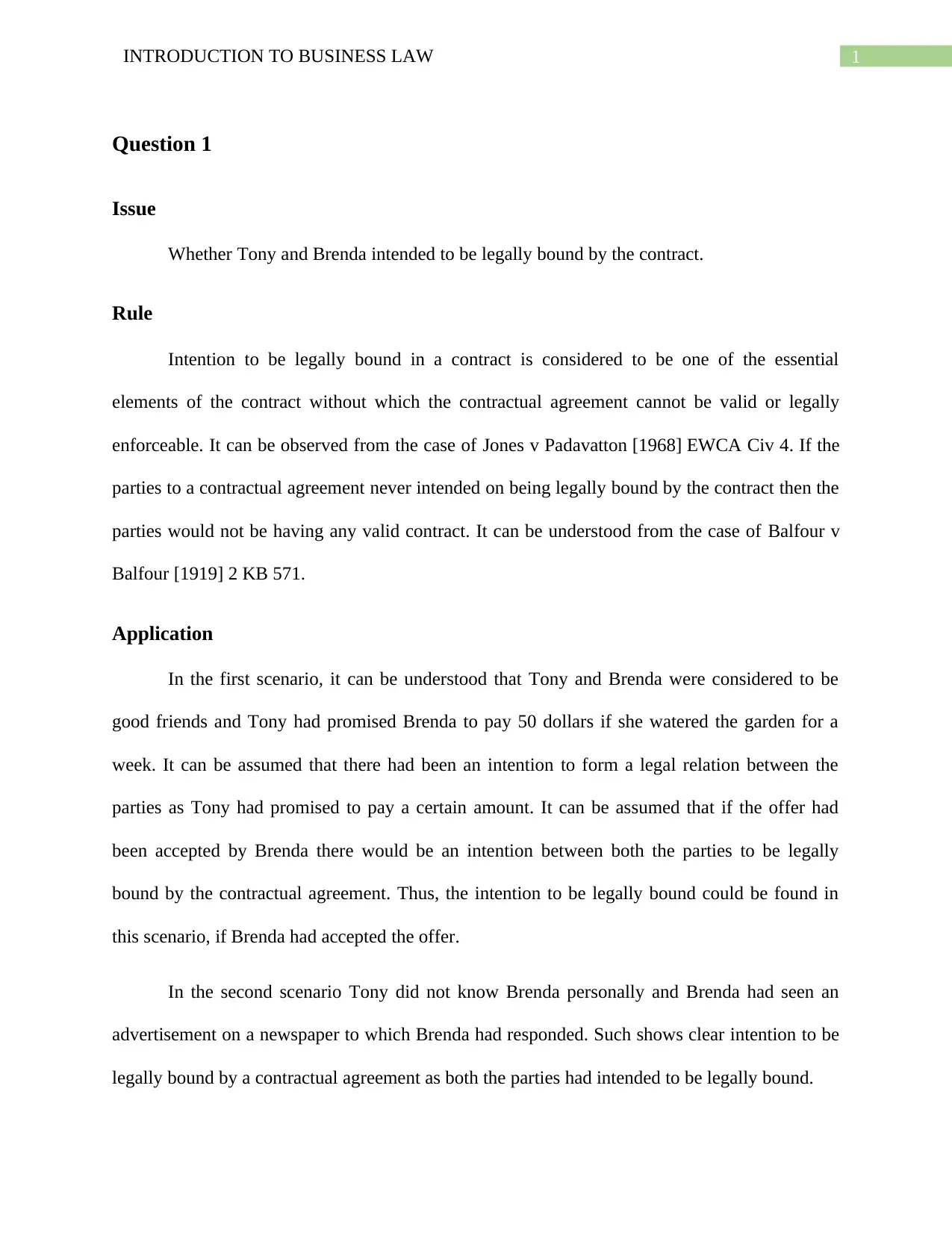
1INTRODUCTION TO BUSINESS LAW
Question 1
Issue
Whether Tony and Brenda intended to be legally bound by the contract.
Rule
Intention to be legally bound in a contract is considered to be one of the essential
elements of the contract without which the contractual agreement cannot be valid or legally
enforceable. It can be observed from the case of Jones v Padavatton [1968] EWCA Civ 4. If the
parties to a contractual agreement never intended on being legally bound by the contract then the
parties would not be having any valid contract. It can be understood from the case of Balfour v
Balfour [1919] 2 KB 571.
Application
In the first scenario, it can be understood that Tony and Brenda were considered to be
good friends and Tony had promised Brenda to pay 50 dollars if she watered the garden for a
week. It can be assumed that there had been an intention to form a legal relation between the
parties as Tony had promised to pay a certain amount. It can be assumed that if the offer had
been accepted by Brenda there would be an intention between both the parties to be legally
bound by the contractual agreement. Thus, the intention to be legally bound could be found in
this scenario, if Brenda had accepted the offer.
In the second scenario Tony did not know Brenda personally and Brenda had seen an
advertisement on a newspaper to which Brenda had responded. Such shows clear intention to be
legally bound by a contractual agreement as both the parties had intended to be legally bound.
Question 1
Issue
Whether Tony and Brenda intended to be legally bound by the contract.
Rule
Intention to be legally bound in a contract is considered to be one of the essential
elements of the contract without which the contractual agreement cannot be valid or legally
enforceable. It can be observed from the case of Jones v Padavatton [1968] EWCA Civ 4. If the
parties to a contractual agreement never intended on being legally bound by the contract then the
parties would not be having any valid contract. It can be understood from the case of Balfour v
Balfour [1919] 2 KB 571.
Application
In the first scenario, it can be understood that Tony and Brenda were considered to be
good friends and Tony had promised Brenda to pay 50 dollars if she watered the garden for a
week. It can be assumed that there had been an intention to form a legal relation between the
parties as Tony had promised to pay a certain amount. It can be assumed that if the offer had
been accepted by Brenda there would be an intention between both the parties to be legally
bound by the contractual agreement. Thus, the intention to be legally bound could be found in
this scenario, if Brenda had accepted the offer.
In the second scenario Tony did not know Brenda personally and Brenda had seen an
advertisement on a newspaper to which Brenda had responded. Such shows clear intention to be
legally bound by a contractual agreement as both the parties had intended to be legally bound.
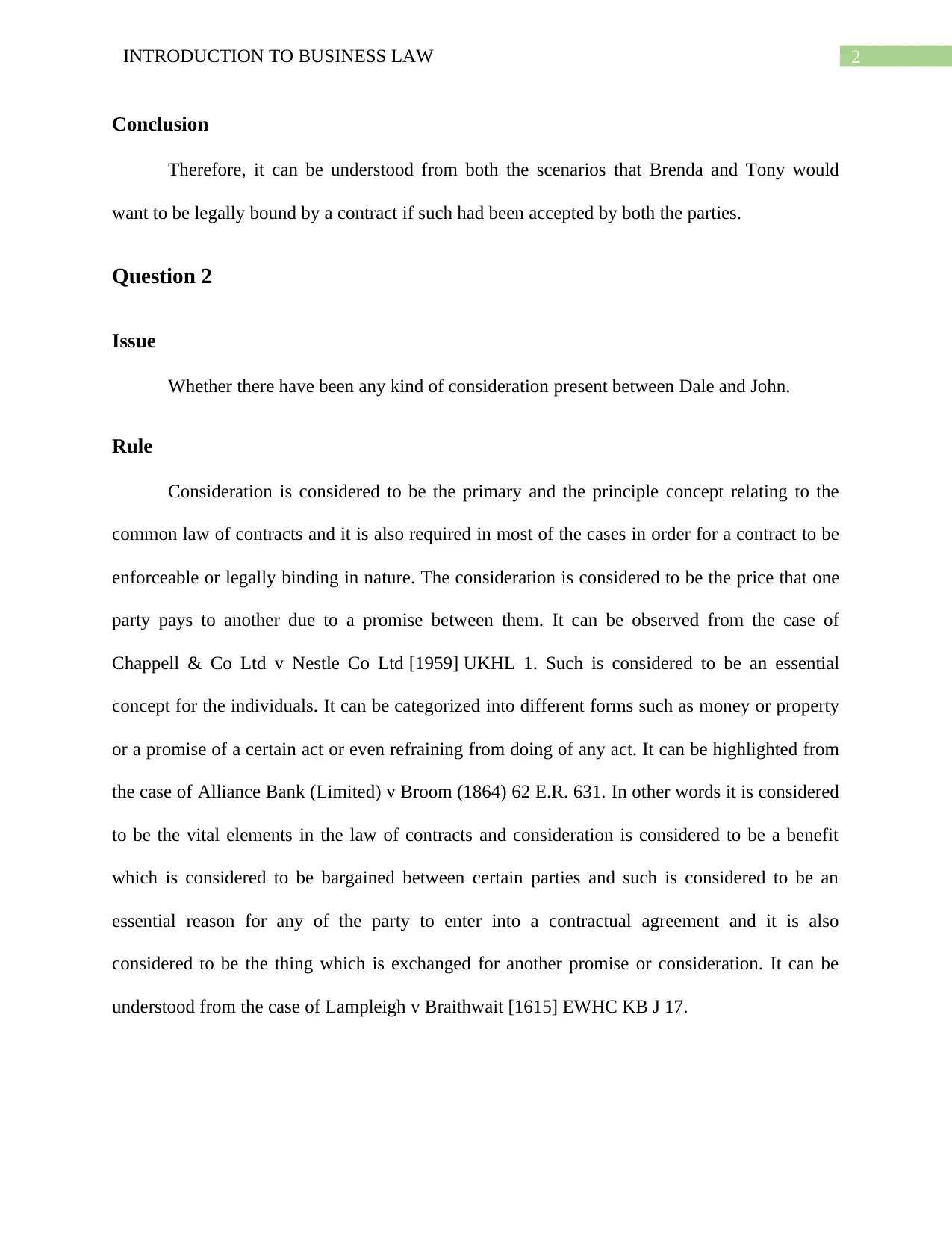
2INTRODUCTION TO BUSINESS LAW
Conclusion
Therefore, it can be understood from both the scenarios that Brenda and Tony would
want to be legally bound by a contract if such had been accepted by both the parties.
Question 2
Issue
Whether there have been any kind of consideration present between Dale and John.
Rule
Consideration is considered to be the primary and the principle concept relating to the
common law of contracts and it is also required in most of the cases in order for a contract to be
enforceable or legally binding in nature. The consideration is considered to be the price that one
party pays to another due to a promise between them. It can be observed from the case of
Chappell & Co Ltd v Nestle Co Ltd [1959] UKHL 1. Such is considered to be an essential
concept for the individuals. It can be categorized into different forms such as money or property
or a promise of a certain act or even refraining from doing of any act. It can be highlighted from
the case of Alliance Bank (Limited) v Broom (1864) 62 E.R. 631. In other words it is considered
to be the vital elements in the law of contracts and consideration is considered to be a benefit
which is considered to be bargained between certain parties and such is considered to be an
essential reason for any of the party to enter into a contractual agreement and it is also
considered to be the thing which is exchanged for another promise or consideration. It can be
understood from the case of Lampleigh v Braithwait [1615] EWHC KB J 17.
Conclusion
Therefore, it can be understood from both the scenarios that Brenda and Tony would
want to be legally bound by a contract if such had been accepted by both the parties.
Question 2
Issue
Whether there have been any kind of consideration present between Dale and John.
Rule
Consideration is considered to be the primary and the principle concept relating to the
common law of contracts and it is also required in most of the cases in order for a contract to be
enforceable or legally binding in nature. The consideration is considered to be the price that one
party pays to another due to a promise between them. It can be observed from the case of
Chappell & Co Ltd v Nestle Co Ltd [1959] UKHL 1. Such is considered to be an essential
concept for the individuals. It can be categorized into different forms such as money or property
or a promise of a certain act or even refraining from doing of any act. It can be highlighted from
the case of Alliance Bank (Limited) v Broom (1864) 62 E.R. 631. In other words it is considered
to be the vital elements in the law of contracts and consideration is considered to be a benefit
which is considered to be bargained between certain parties and such is considered to be an
essential reason for any of the party to enter into a contractual agreement and it is also
considered to be the thing which is exchanged for another promise or consideration. It can be
understood from the case of Lampleigh v Braithwait [1615] EWHC KB J 17.
⊘ This is a preview!⊘
Do you want full access?
Subscribe today to unlock all pages.

Trusted by 1+ million students worldwide
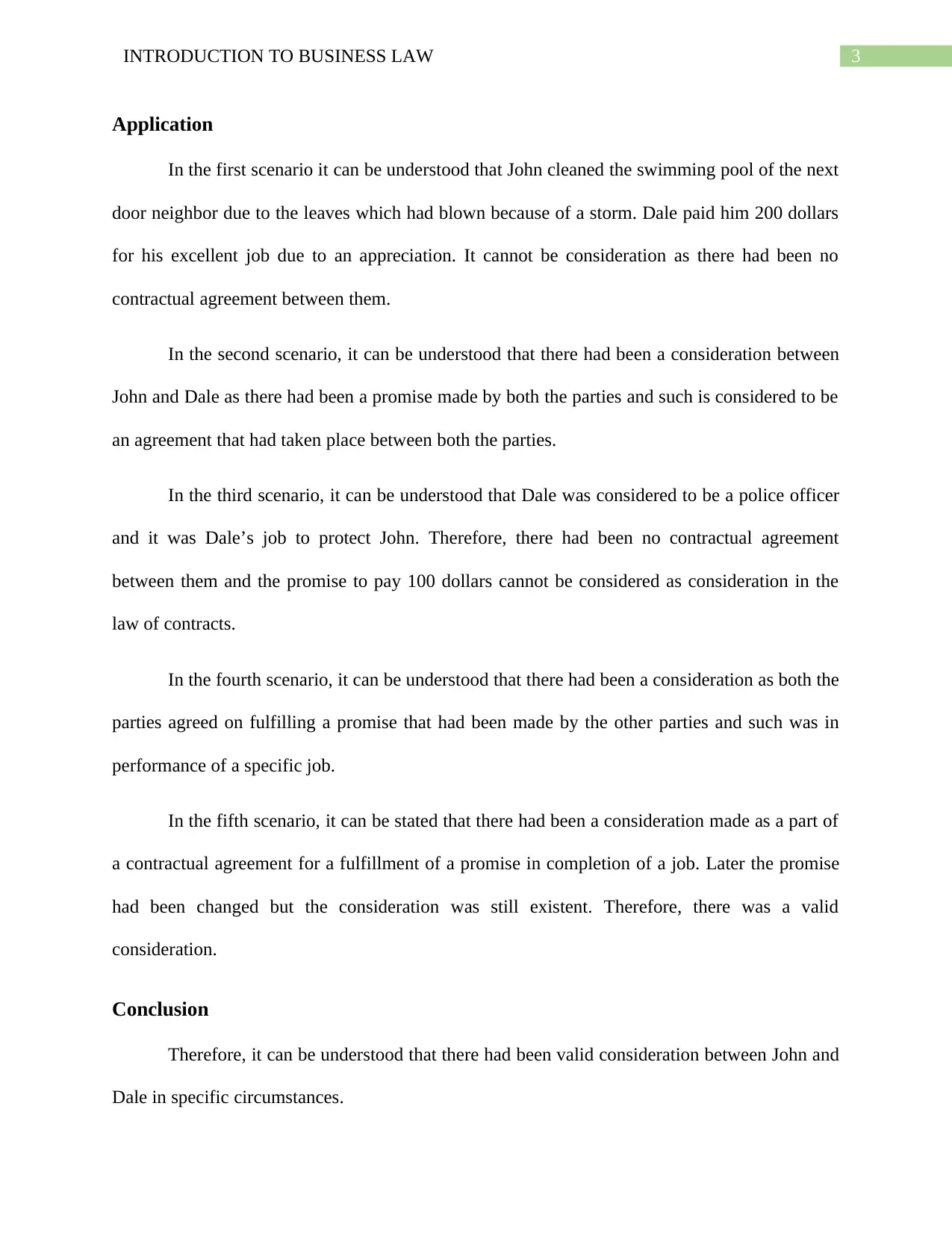
3INTRODUCTION TO BUSINESS LAW
Application
In the first scenario it can be understood that John cleaned the swimming pool of the next
door neighbor due to the leaves which had blown because of a storm. Dale paid him 200 dollars
for his excellent job due to an appreciation. It cannot be consideration as there had been no
contractual agreement between them.
In the second scenario, it can be understood that there had been a consideration between
John and Dale as there had been a promise made by both the parties and such is considered to be
an agreement that had taken place between both the parties.
In the third scenario, it can be understood that Dale was considered to be a police officer
and it was Dale’s job to protect John. Therefore, there had been no contractual agreement
between them and the promise to pay 100 dollars cannot be considered as consideration in the
law of contracts.
In the fourth scenario, it can be understood that there had been a consideration as both the
parties agreed on fulfilling a promise that had been made by the other parties and such was in
performance of a specific job.
In the fifth scenario, it can be stated that there had been a consideration made as a part of
a contractual agreement for a fulfillment of a promise in completion of a job. Later the promise
had been changed but the consideration was still existent. Therefore, there was a valid
consideration.
Conclusion
Therefore, it can be understood that there had been valid consideration between John and
Dale in specific circumstances.
Application
In the first scenario it can be understood that John cleaned the swimming pool of the next
door neighbor due to the leaves which had blown because of a storm. Dale paid him 200 dollars
for his excellent job due to an appreciation. It cannot be consideration as there had been no
contractual agreement between them.
In the second scenario, it can be understood that there had been a consideration between
John and Dale as there had been a promise made by both the parties and such is considered to be
an agreement that had taken place between both the parties.
In the third scenario, it can be understood that Dale was considered to be a police officer
and it was Dale’s job to protect John. Therefore, there had been no contractual agreement
between them and the promise to pay 100 dollars cannot be considered as consideration in the
law of contracts.
In the fourth scenario, it can be understood that there had been a consideration as both the
parties agreed on fulfilling a promise that had been made by the other parties and such was in
performance of a specific job.
In the fifth scenario, it can be stated that there had been a consideration made as a part of
a contractual agreement for a fulfillment of a promise in completion of a job. Later the promise
had been changed but the consideration was still existent. Therefore, there was a valid
consideration.
Conclusion
Therefore, it can be understood that there had been valid consideration between John and
Dale in specific circumstances.
Paraphrase This Document
Need a fresh take? Get an instant paraphrase of this document with our AI Paraphraser
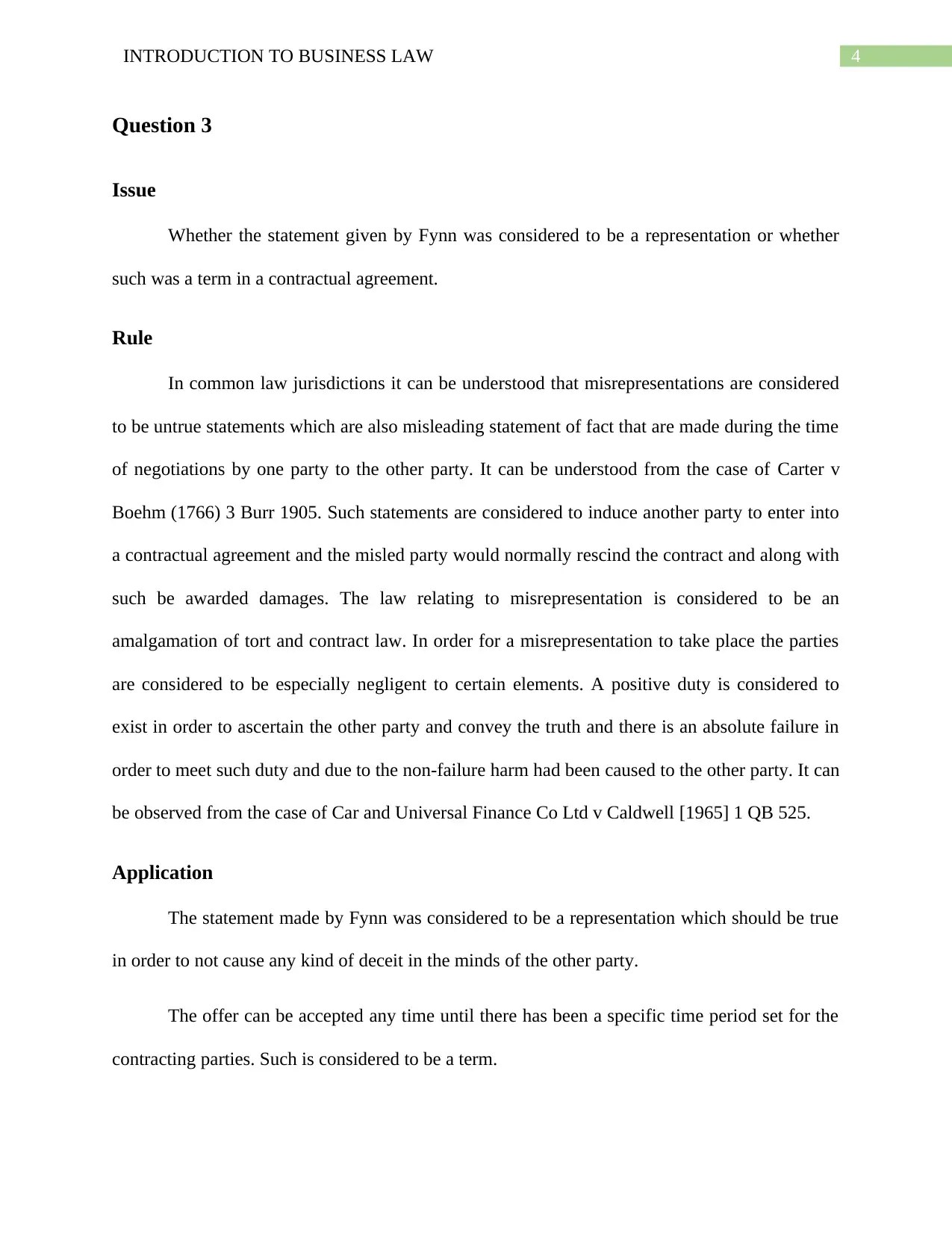
4INTRODUCTION TO BUSINESS LAW
Question 3
Issue
Whether the statement given by Fynn was considered to be a representation or whether
such was a term in a contractual agreement.
Rule
In common law jurisdictions it can be understood that misrepresentations are considered
to be untrue statements which are also misleading statement of fact that are made during the time
of negotiations by one party to the other party. It can be understood from the case of Carter v
Boehm (1766) 3 Burr 1905. Such statements are considered to induce another party to enter into
a contractual agreement and the misled party would normally rescind the contract and along with
such be awarded damages. The law relating to misrepresentation is considered to be an
amalgamation of tort and contract law. In order for a misrepresentation to take place the parties
are considered to be especially negligent to certain elements. A positive duty is considered to
exist in order to ascertain the other party and convey the truth and there is an absolute failure in
order to meet such duty and due to the non-failure harm had been caused to the other party. It can
be observed from the case of Car and Universal Finance Co Ltd v Caldwell [1965] 1 QB 525.
Application
The statement made by Fynn was considered to be a representation which should be true
in order to not cause any kind of deceit in the minds of the other party.
The offer can be accepted any time until there has been a specific time period set for the
contracting parties. Such is considered to be a term.
Question 3
Issue
Whether the statement given by Fynn was considered to be a representation or whether
such was a term in a contractual agreement.
Rule
In common law jurisdictions it can be understood that misrepresentations are considered
to be untrue statements which are also misleading statement of fact that are made during the time
of negotiations by one party to the other party. It can be understood from the case of Carter v
Boehm (1766) 3 Burr 1905. Such statements are considered to induce another party to enter into
a contractual agreement and the misled party would normally rescind the contract and along with
such be awarded damages. The law relating to misrepresentation is considered to be an
amalgamation of tort and contract law. In order for a misrepresentation to take place the parties
are considered to be especially negligent to certain elements. A positive duty is considered to
exist in order to ascertain the other party and convey the truth and there is an absolute failure in
order to meet such duty and due to the non-failure harm had been caused to the other party. It can
be observed from the case of Car and Universal Finance Co Ltd v Caldwell [1965] 1 QB 525.
Application
The statement made by Fynn was considered to be a representation which should be true
in order to not cause any kind of deceit in the minds of the other party.
The offer can be accepted any time until there has been a specific time period set for the
contracting parties. Such is considered to be a term.
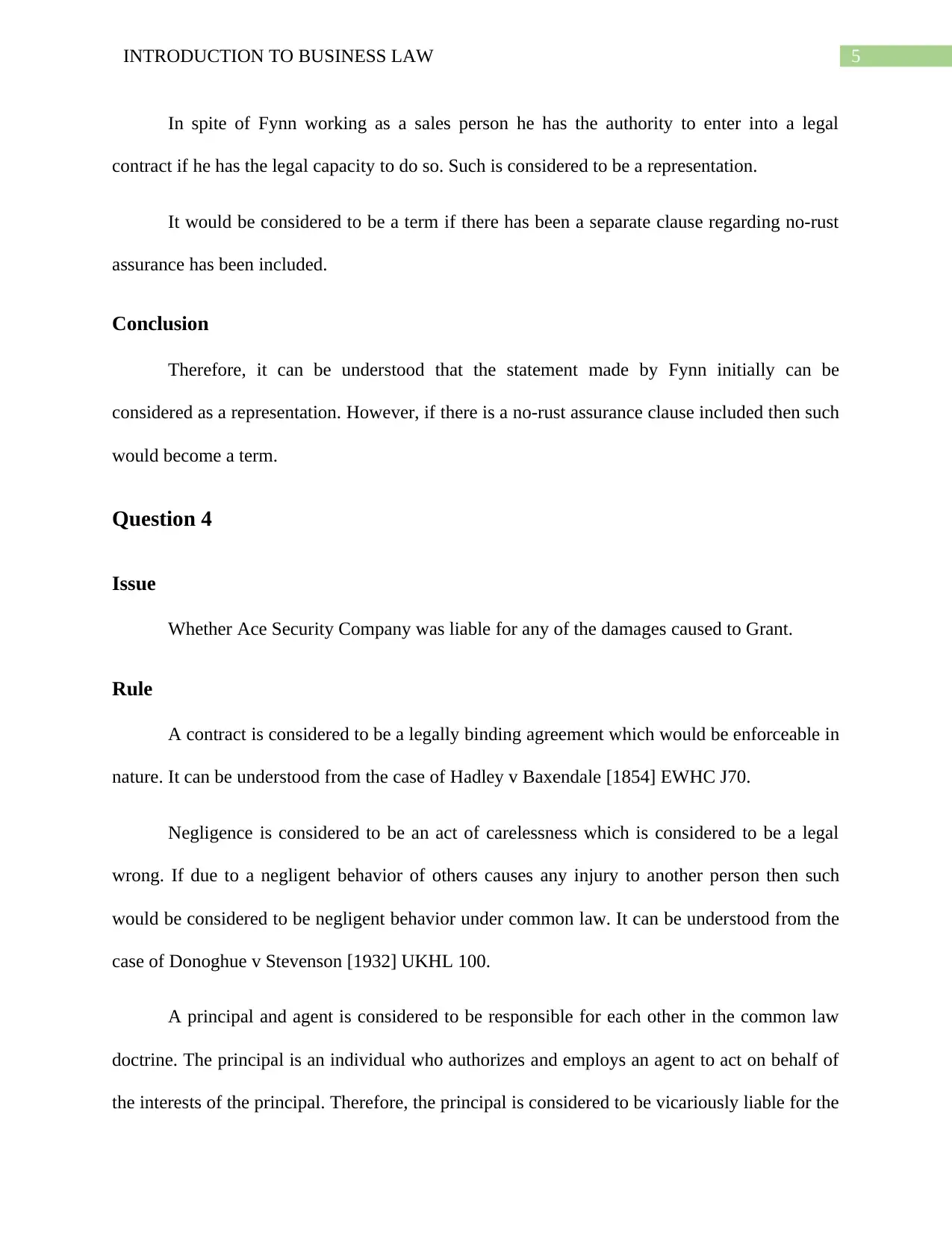
5INTRODUCTION TO BUSINESS LAW
In spite of Fynn working as a sales person he has the authority to enter into a legal
contract if he has the legal capacity to do so. Such is considered to be a representation.
It would be considered to be a term if there has been a separate clause regarding no-rust
assurance has been included.
Conclusion
Therefore, it can be understood that the statement made by Fynn initially can be
considered as a representation. However, if there is a no-rust assurance clause included then such
would become a term.
Question 4
Issue
Whether Ace Security Company was liable for any of the damages caused to Grant.
Rule
A contract is considered to be a legally binding agreement which would be enforceable in
nature. It can be understood from the case of Hadley v Baxendale [1854] EWHC J70.
Negligence is considered to be an act of carelessness which is considered to be a legal
wrong. If due to a negligent behavior of others causes any injury to another person then such
would be considered to be negligent behavior under common law. It can be understood from the
case of Donoghue v Stevenson [1932] UKHL 100.
A principal and agent is considered to be responsible for each other in the common law
doctrine. The principal is an individual who authorizes and employs an agent to act on behalf of
the interests of the principal. Therefore, the principal is considered to be vicariously liable for the
In spite of Fynn working as a sales person he has the authority to enter into a legal
contract if he has the legal capacity to do so. Such is considered to be a representation.
It would be considered to be a term if there has been a separate clause regarding no-rust
assurance has been included.
Conclusion
Therefore, it can be understood that the statement made by Fynn initially can be
considered as a representation. However, if there is a no-rust assurance clause included then such
would become a term.
Question 4
Issue
Whether Ace Security Company was liable for any of the damages caused to Grant.
Rule
A contract is considered to be a legally binding agreement which would be enforceable in
nature. It can be understood from the case of Hadley v Baxendale [1854] EWHC J70.
Negligence is considered to be an act of carelessness which is considered to be a legal
wrong. If due to a negligent behavior of others causes any injury to another person then such
would be considered to be negligent behavior under common law. It can be understood from the
case of Donoghue v Stevenson [1932] UKHL 100.
A principal and agent is considered to be responsible for each other in the common law
doctrine. The principal is an individual who authorizes and employs an agent to act on behalf of
the interests of the principal. Therefore, the principal is considered to be vicariously liable for the
⊘ This is a preview!⊘
Do you want full access?
Subscribe today to unlock all pages.

Trusted by 1+ million students worldwide
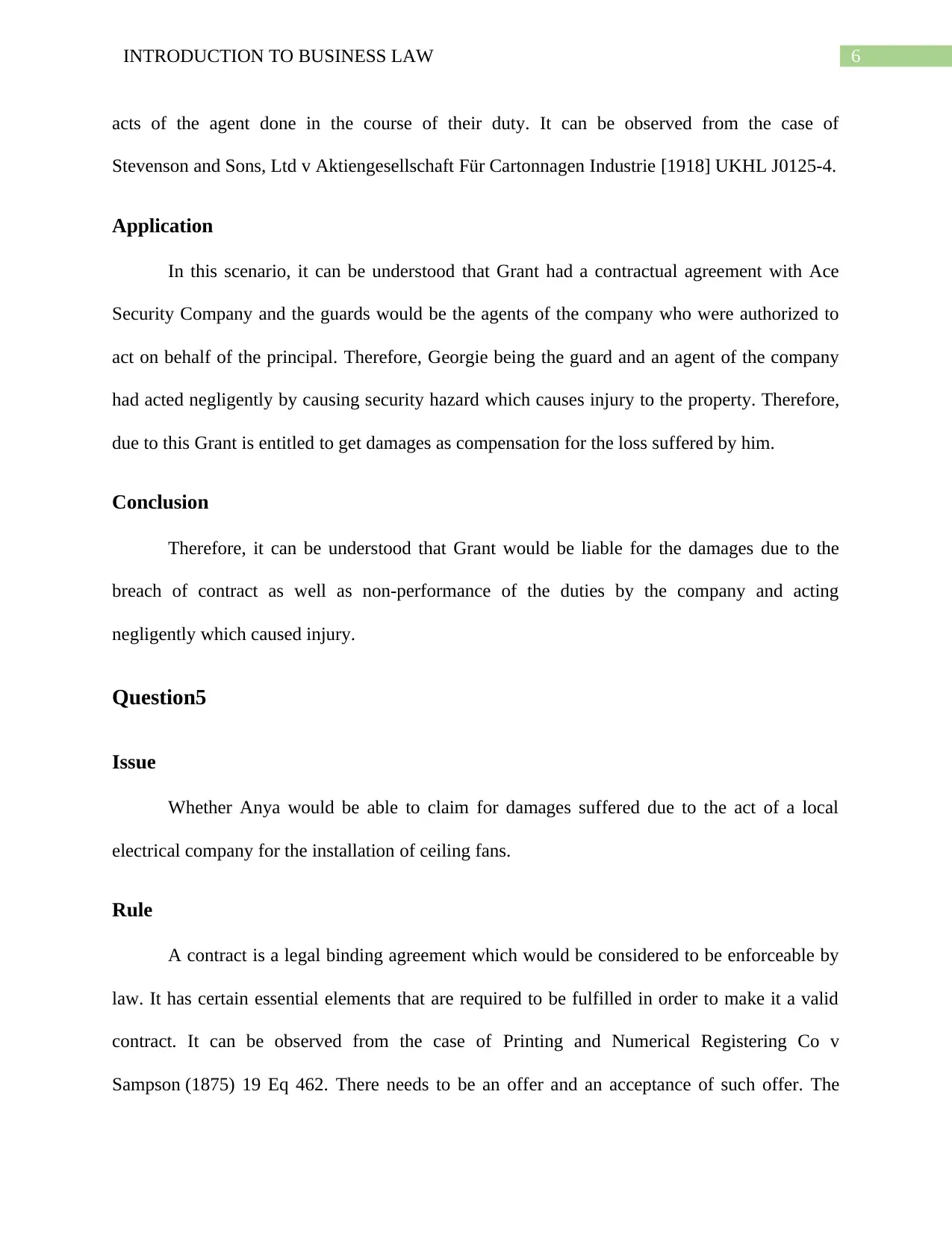
6INTRODUCTION TO BUSINESS LAW
acts of the agent done in the course of their duty. It can be observed from the case of
Stevenson and Sons, Ltd v Aktiengesellschaft Für Cartonnagen Industrie [1918] UKHL J0125-4.
Application
In this scenario, it can be understood that Grant had a contractual agreement with Ace
Security Company and the guards would be the agents of the company who were authorized to
act on behalf of the principal. Therefore, Georgie being the guard and an agent of the company
had acted negligently by causing security hazard which causes injury to the property. Therefore,
due to this Grant is entitled to get damages as compensation for the loss suffered by him.
Conclusion
Therefore, it can be understood that Grant would be liable for the damages due to the
breach of contract as well as non-performance of the duties by the company and acting
negligently which caused injury.
Question5
Issue
Whether Anya would be able to claim for damages suffered due to the act of a local
electrical company for the installation of ceiling fans.
Rule
A contract is a legal binding agreement which would be considered to be enforceable by
law. It has certain essential elements that are required to be fulfilled in order to make it a valid
contract. It can be observed from the case of Printing and Numerical Registering Co v
Sampson (1875) 19 Eq 462. There needs to be an offer and an acceptance of such offer. The
acts of the agent done in the course of their duty. It can be observed from the case of
Stevenson and Sons, Ltd v Aktiengesellschaft Für Cartonnagen Industrie [1918] UKHL J0125-4.
Application
In this scenario, it can be understood that Grant had a contractual agreement with Ace
Security Company and the guards would be the agents of the company who were authorized to
act on behalf of the principal. Therefore, Georgie being the guard and an agent of the company
had acted negligently by causing security hazard which causes injury to the property. Therefore,
due to this Grant is entitled to get damages as compensation for the loss suffered by him.
Conclusion
Therefore, it can be understood that Grant would be liable for the damages due to the
breach of contract as well as non-performance of the duties by the company and acting
negligently which caused injury.
Question5
Issue
Whether Anya would be able to claim for damages suffered due to the act of a local
electrical company for the installation of ceiling fans.
Rule
A contract is a legal binding agreement which would be considered to be enforceable by
law. It has certain essential elements that are required to be fulfilled in order to make it a valid
contract. It can be observed from the case of Printing and Numerical Registering Co v
Sampson (1875) 19 Eq 462. There needs to be an offer and an acceptance of such offer. The
Paraphrase This Document
Need a fresh take? Get an instant paraphrase of this document with our AI Paraphraser
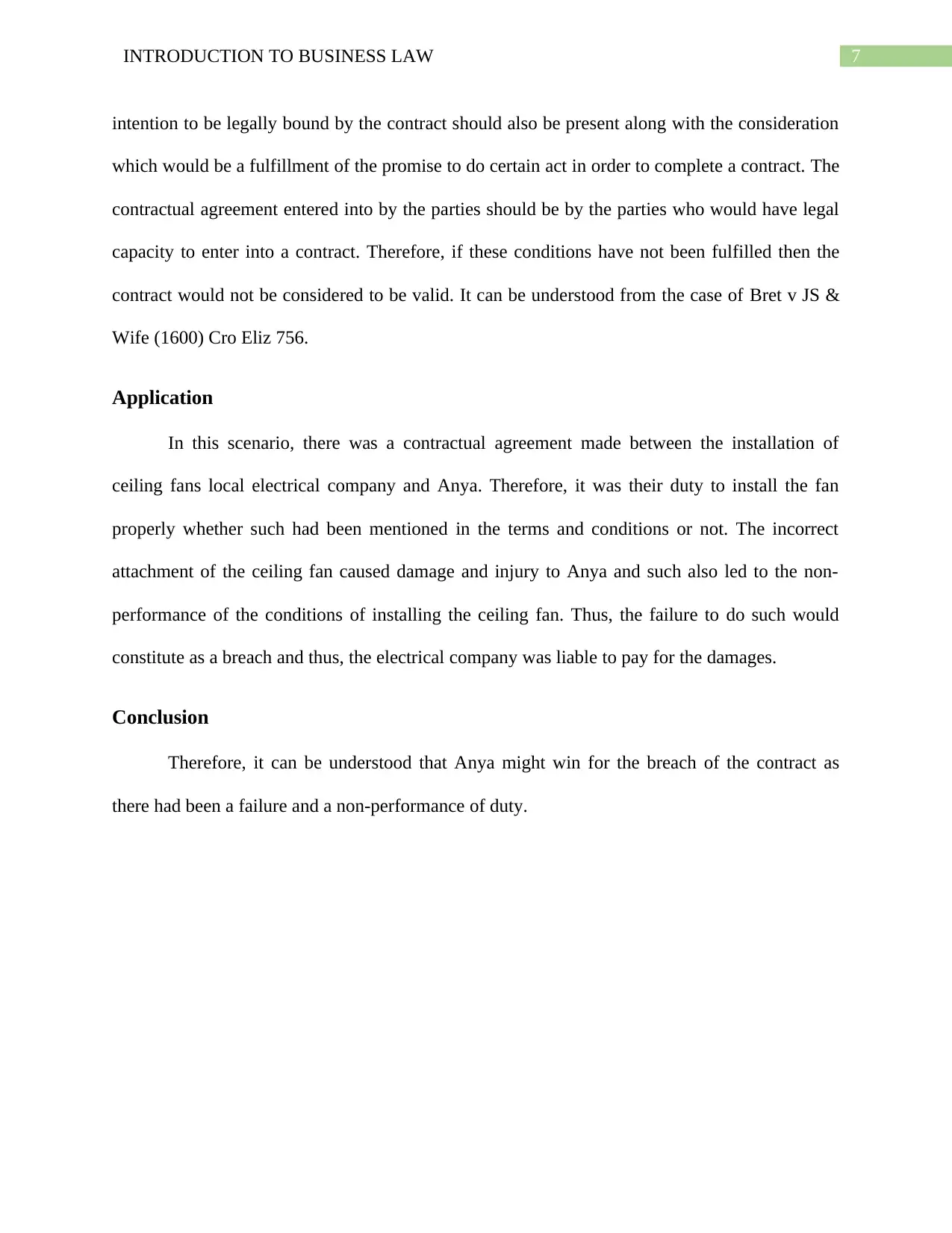
7INTRODUCTION TO BUSINESS LAW
intention to be legally bound by the contract should also be present along with the consideration
which would be a fulfillment of the promise to do certain act in order to complete a contract. The
contractual agreement entered into by the parties should be by the parties who would have legal
capacity to enter into a contract. Therefore, if these conditions have not been fulfilled then the
contract would not be considered to be valid. It can be understood from the case of Bret v JS &
Wife (1600) Cro Eliz 756.
Application
In this scenario, there was a contractual agreement made between the installation of
ceiling fans local electrical company and Anya. Therefore, it was their duty to install the fan
properly whether such had been mentioned in the terms and conditions or not. The incorrect
attachment of the ceiling fan caused damage and injury to Anya and such also led to the non-
performance of the conditions of installing the ceiling fan. Thus, the failure to do such would
constitute as a breach and thus, the electrical company was liable to pay for the damages.
Conclusion
Therefore, it can be understood that Anya might win for the breach of the contract as
there had been a failure and a non-performance of duty.
intention to be legally bound by the contract should also be present along with the consideration
which would be a fulfillment of the promise to do certain act in order to complete a contract. The
contractual agreement entered into by the parties should be by the parties who would have legal
capacity to enter into a contract. Therefore, if these conditions have not been fulfilled then the
contract would not be considered to be valid. It can be understood from the case of Bret v JS &
Wife (1600) Cro Eliz 756.
Application
In this scenario, there was a contractual agreement made between the installation of
ceiling fans local electrical company and Anya. Therefore, it was their duty to install the fan
properly whether such had been mentioned in the terms and conditions or not. The incorrect
attachment of the ceiling fan caused damage and injury to Anya and such also led to the non-
performance of the conditions of installing the ceiling fan. Thus, the failure to do such would
constitute as a breach and thus, the electrical company was liable to pay for the damages.
Conclusion
Therefore, it can be understood that Anya might win for the breach of the contract as
there had been a failure and a non-performance of duty.
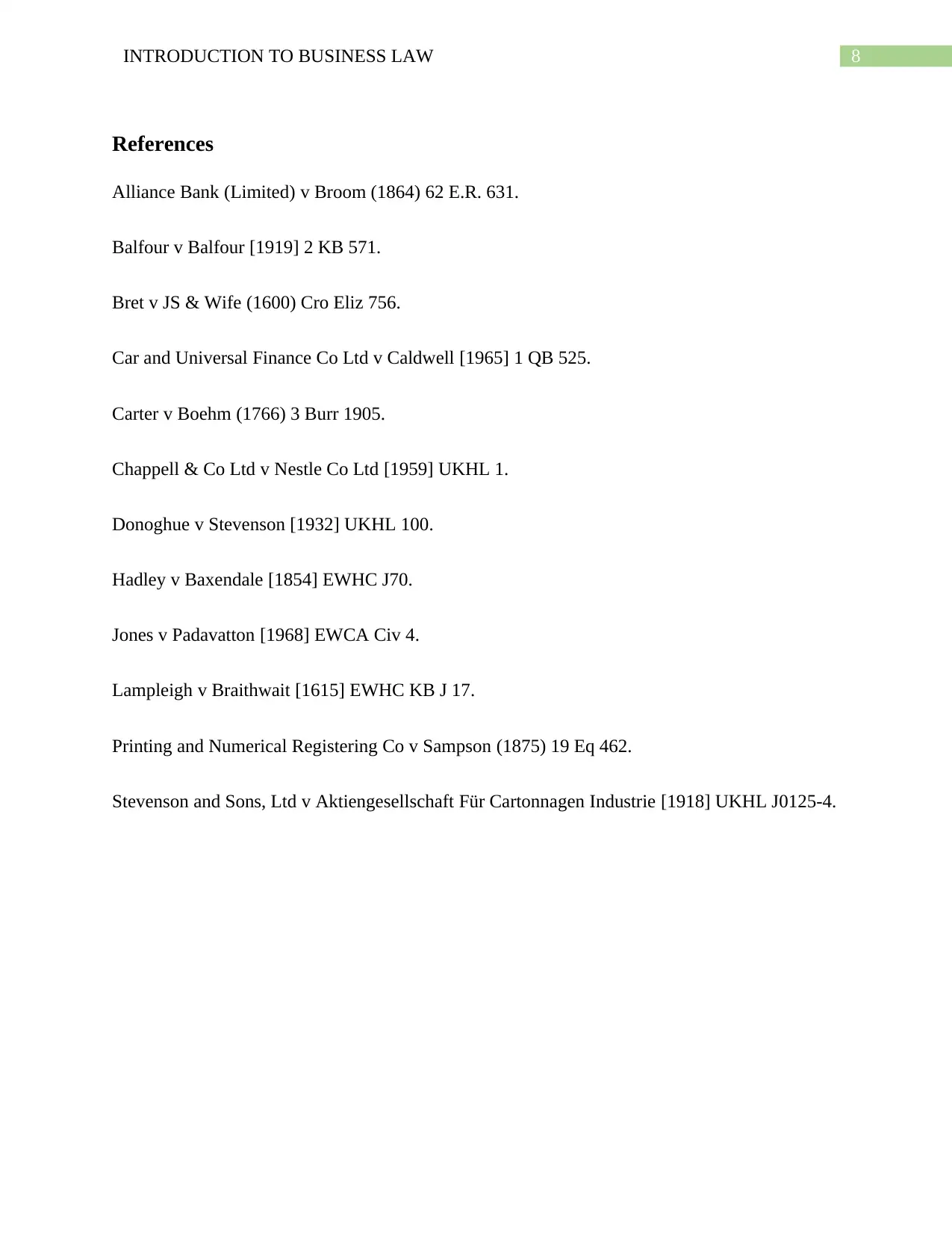
8INTRODUCTION TO BUSINESS LAW
References
Alliance Bank (Limited) v Broom (1864) 62 E.R. 631.
Balfour v Balfour [1919] 2 KB 571.
Bret v JS & Wife (1600) Cro Eliz 756.
Car and Universal Finance Co Ltd v Caldwell [1965] 1 QB 525.
Carter v Boehm (1766) 3 Burr 1905.
Chappell & Co Ltd v Nestle Co Ltd [1959] UKHL 1.
Donoghue v Stevenson [1932] UKHL 100.
Hadley v Baxendale [1854] EWHC J70.
Jones v Padavatton [1968] EWCA Civ 4.
Lampleigh v Braithwait [1615] EWHC KB J 17.
Printing and Numerical Registering Co v Sampson (1875) 19 Eq 462.
Stevenson and Sons, Ltd v Aktiengesellschaft Für Cartonnagen Industrie [1918] UKHL J0125-4.
References
Alliance Bank (Limited) v Broom (1864) 62 E.R. 631.
Balfour v Balfour [1919] 2 KB 571.
Bret v JS & Wife (1600) Cro Eliz 756.
Car and Universal Finance Co Ltd v Caldwell [1965] 1 QB 525.
Carter v Boehm (1766) 3 Burr 1905.
Chappell & Co Ltd v Nestle Co Ltd [1959] UKHL 1.
Donoghue v Stevenson [1932] UKHL 100.
Hadley v Baxendale [1854] EWHC J70.
Jones v Padavatton [1968] EWCA Civ 4.
Lampleigh v Braithwait [1615] EWHC KB J 17.
Printing and Numerical Registering Co v Sampson (1875) 19 Eq 462.
Stevenson and Sons, Ltd v Aktiengesellschaft Für Cartonnagen Industrie [1918] UKHL J0125-4.
⊘ This is a preview!⊘
Do you want full access?
Subscribe today to unlock all pages.

Trusted by 1+ million students worldwide
1 out of 9
Related Documents
Your All-in-One AI-Powered Toolkit for Academic Success.
+13062052269
info@desklib.com
Available 24*7 on WhatsApp / Email
![[object Object]](/_next/static/media/star-bottom.7253800d.svg)
Unlock your academic potential
Copyright © 2020–2025 A2Z Services. All Rights Reserved. Developed and managed by ZUCOL.





